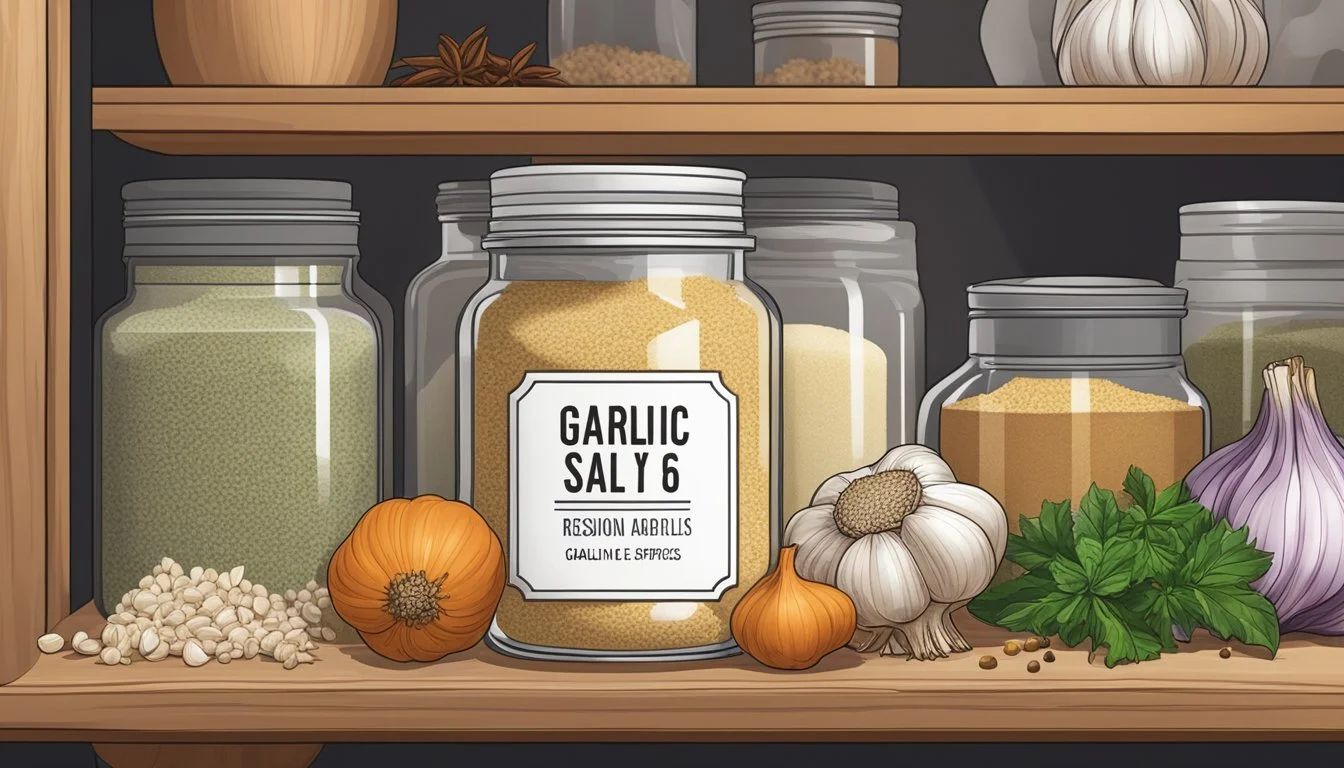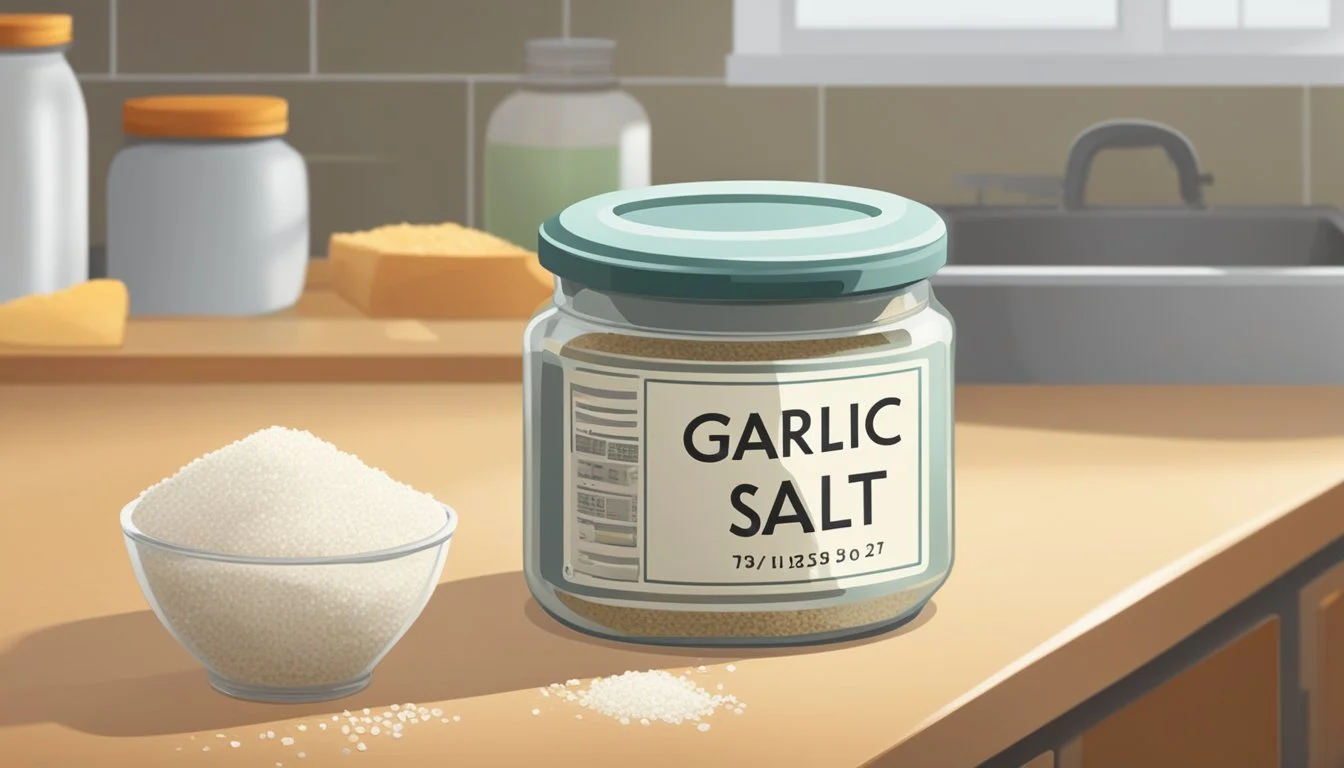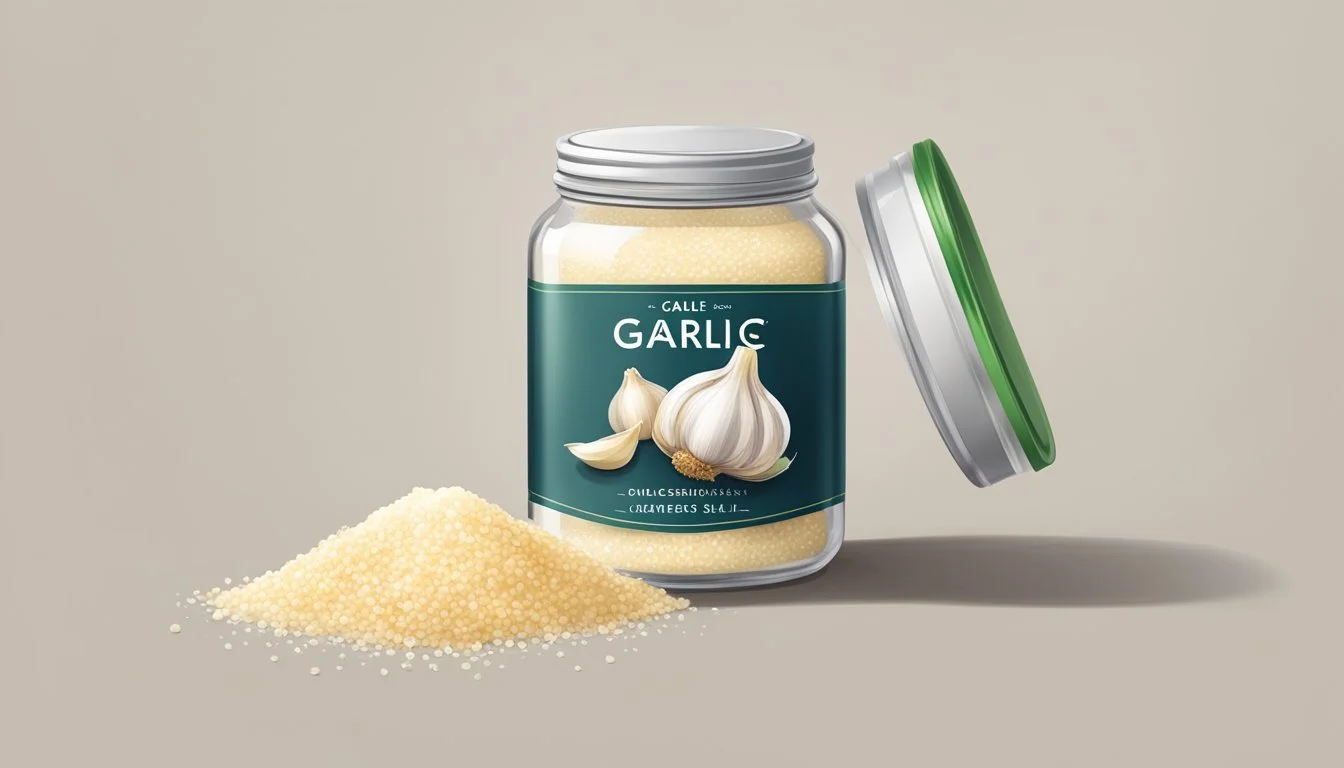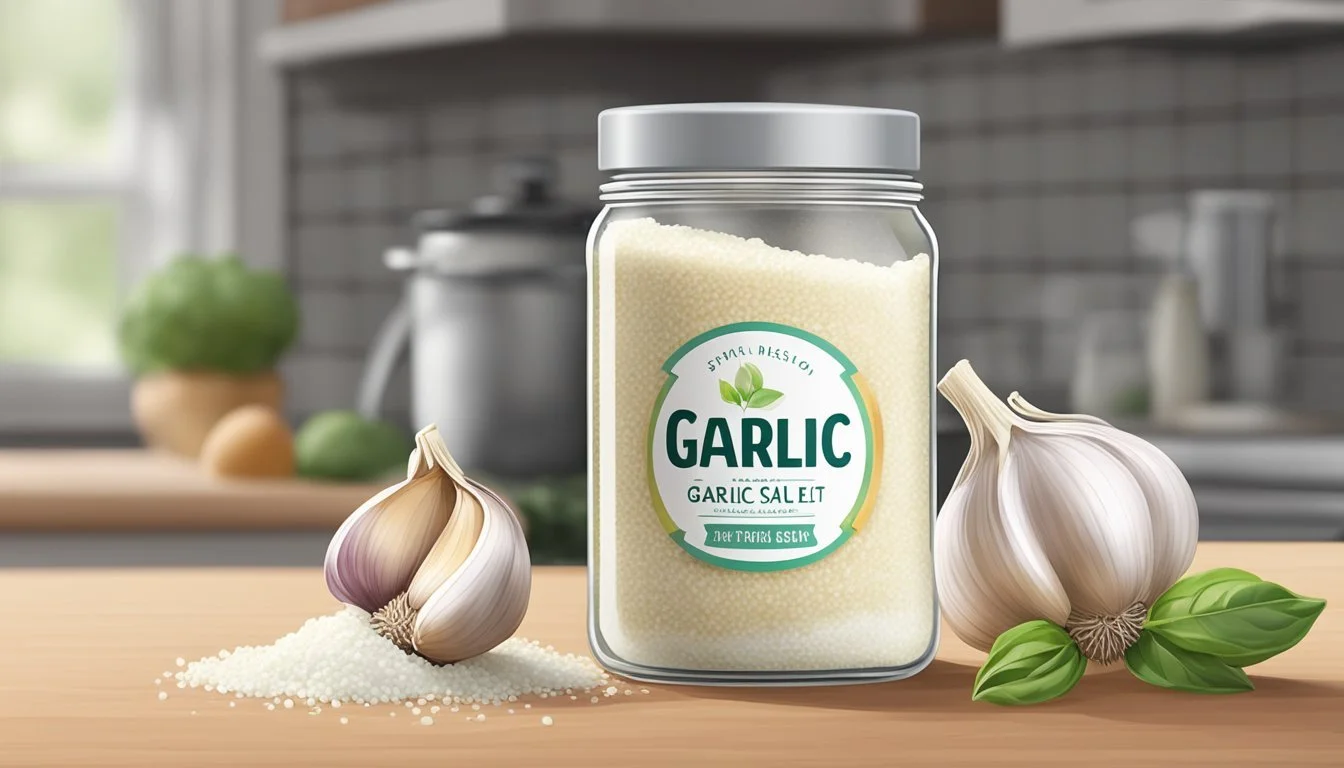How Long Does Garlic Salt Last?
Shelf Life and Storage Tips
Garlic (What wine goes well with garlic?) salt is a staple seasoning blend composed of garlic powder (how long does garlic powder last?) and salt, often found in many kitchens for its ability to enhance the flavor profile of various dishes. Unlike fresh produce, garlic salt doesn't spoil in a way that makes it unsafe to consume, but it does have a shelf life during which its quality, in terms of flavor and potency, is considered to be at its best.
Most manufacturers recommend using garlic salt within two years of the purchase date to ensure its maximum freshness and taste. While it may still be safe to use beyond this timeframe, the seasoning might exhibit a decrease in its characteristic robust taste and aroma. The longevity of garlic salt's quality is largely contingent on proper storage practices.
To retain the best quality of garlic salt, it should be stored in a cool, dry place, away from moisture and heat sources. Containers with tight-fitting lids are ideal for bulk quantities and can assist in preserving the seasoning's flavor and potency for approximately two to three years. Keeping garlic salt in appropriate conditions helps maintain its inherent qualities and enhances the shelf life significantly.
Understanding Garlic Salt
Garlic salt serves as a seasoning staple, combining the robust flavor of garlic and the preserving qualities of salt. It imparts a distinct aroma and taste to various dishes.
Composition
Garlic salt is a blend of two primary ingredients: garlic and salt. Typically, it consists of three parts salt to one part garlic, a mixture that includes granulated garlic or garlic powder and table salt or sea salt (how long does sea salt last?). This combination synergizes—the salt naturally preserves the garlic flavor, enabling it to remain in culinary use over an extended period.
Benefits of Garlic Salt
The benefits of using garlic salt as a seasoning are twofold: it offers the convenience of two staple ingredients in one product and provides a consistent flavor profile to dishes. It is particularly useful when a dish requires both seasoning elements, streamlining the cooking process. Garlic salt retains its potency and aroma longer than pure garlic, due to the preservative effect of the salt component.
Shelf Life and Quality Indicators
When discussing garlic salt, it is important to consider its shelf life, which can extend up to 2-3 years. This longevity is subject to its exposure to various environmental factors, and can impact quality in terms of taste, color, texture, and potency. Now, let's examine the factors that affect its shelf life, changes in its quality over time, and indicators that the product might be expiring.
Factors Affecting Shelf Life
The shelf life of garlic salt is primarily influenced by the following factors:
Storage conditions: Keeping garlic salt in a cool, dry place away from direct sunlight ensures maximum shelf life.
Packaging: Containers with tight-fitting lids are preferable as they protect the salt from moisture and contaminants.
Quality of the product: Higher quality ingredients tend to maintain their characteristics longer.
Quality Over Time
Garlic salt's quality can degrade over time, reflected in its:
Taste: A notable loss in flavor potency may occur.
Odor: The distinct garlic aroma might weaken.
Color: If exposure to moisture or contaminants occurs, discoloration may indicate quality degradation.
Texture: Clumping signifies moisture exposure and suggests a quality decline.
Expiration Indicators
One can recognize that garlic salt is no longer at its best quality or potentially spoiled by noticing:
Texture change: Clumping from moisture absorption is a clear sign.
Odor alteration: The loss of garlic's pungent smell indicates potential spoilage.
Color shift: Any significant change in color implies a decrease in product quality.
Taste reduction: A bland flavor signifies the loss of its original potency and a decline in overall quality.
Proper Storage Techniques
To maintain the quality and extend the longevity of garlic salt, correct storage is essential. This involves regulating environmental factors such as temperature and moisture, and utilizing proper storage containers.
Storage Conditions
Temperature: Garlic salt should be kept in a cool place, where the temperature is consistently between 60 to 70 degrees Fahrenheit. Extreme temperatures can hasten the loss of potency.
Light and Heat: These are two factors that can degrade garlic salt quickly, so it's crucial to store the seasoning in a dark area, away from direct sunlight, and sources of heat.
Moisture: A dry environment is necessary to prevent caking and preserve the garlic salt's granular texture. High humidity levels can lead to clumping and even mold growth.
Best Practices
Airtight Containers: Place garlic salt in containers with tight-fitting lids to protect it from moisture and other contaminants.
Location: The ideal storage locations are a pantry or cupboard, as they typically provide the requisite cool and dark environment.
Expiration Awareness: While garlic salt does not expire in the traditional sense, one should be aware of the "best by" or expiration date as a guideline for peak quality. After this period, it may lose flavor, though it remains safe to use.
Avoiding Cross Contamination: One should always use a clean, dry spoon to measure out garlic salt, as introducing moisture or contaminants can compromise its quality.
Preventing Spoilage
To maintain the quality and extend the life of garlic salt, it's essential to prevent spoilage by controlling moisture and avoiding contaminants, which can lead to clumping, mold, and bacterial growth.
Controlling Moisture
Garlic salt’s shelf life is significantly affected by moisture. Moisture can cause clumping, which makes the garlic salt difficult to use and can also lead to mold growth. To prevent this:
Storage: Keep the garlic salt in an airtight container to protect it from humidity.
Location: Store it in a cool, dry place away from heat or sunlight which can increase moisture levels.
Avoiding Contaminants
Contaminants like bacteria and bugs can spoil garlic salt. Proper handling practices should be followed:
Utensils: Always use clean, dry utensils when measuring out garlic salt to avoid introducing moisture or bacteria.
Inspection: Regularly check for signs of spoilage, such as unexpected odors or changes in texture, to test for contaminants.
Signs of Deterioration
Garlic salt generally has a long shelf life, but it can deteriorate over time. Particular signs indicate when the seasoning is past its peak quality and may require replacement.
Visual and Olfactory Cues
Color: Fresh garlic salt typically has a light, consistent color. A change in color, such as darkening, suggests it may have been affected by moisture or other contaminants.
Smell: Garlic salt should have a distinct garlicky aroma. A lack of a strong smell can be a sign that the garlic salt is losing its potency and is no longer at its peak condition.
Texture: If garlic salt appears clumpy and hard rather than free-flowing, this indicates that it has absorbed moisture. Such a change in texture can affect the quality and the ease of use.
Overall Integrity: When the garlic salt's scent, texture, or color starts to deviate from its original state, it's an indicator that it has begun to degrade and may not provide the intended flavor profile in cooking.
Usage Tips
When utilizing garlic salt in the kitchen, one must consider its dual role as both a seasoning and preservative. Its ability to enhance dishes with a robust flavor while offering a convenient alternative to fresh garlic can be maximized with the following strategies.
Enhancing Flavors
Garlic salt serves as a versatile ingredient that can easily elevate the taste profile of various dishes. Here are specific tips to make the most out of garlic salt when cooking:
Dose Carefully: Start with a small amount and adjust according to taste, as garlic salt is more potent than regular salt due to the presence of garlic powder.
Balance with Other Spices: Combine with complementary herbs and spices such as paprika, oregano, or basil to create a complex flavor bouquet without overwhelming the dish.
Substituting for Fresh Garlic
For those times when fresh garlic is not available or when convenience is a priority, garlic salt can be a suitable substitute. When doing so, it's important to maintain balance in the dish's seasoning:
Conversion: Use 1/2 teaspoon of garlic salt to replace each clove of fresh garlic, then reduce any additional salt in the recipe to avoid over-salting.
Application: Garlic salt is best used in recipes where it can be evenly distributed, such as in marinades, rubs, or as a finishing touch on vegetables and meats.
Comparative Shelf Life
The longevity of garlic salt compared to other varieties of salt and forms of garlic depends on its components and the manner in which they are processed. Understanding these differences is crucial when considering storage practices and "best by" timelines.
Garlic Salt vs. Other Salts
Regular Salt: Traditional table salt is mined or evaporated from saltwater and is usually highly refined. It can last indefinitely when stored in a dry environment.
Sea Salt: Obtained from evaporated seawater, sea salt typically contains trace minerals and has no definite expiration.
Himalayan Salt: This pink salt is harvested from ancient sea beds and can last indefinitely, similar to regular salt.
Kosher Salt: (how long does kosher salt last?) Coarser and flakier, Kosher salt has a long shelf life but is less dense, so it may seem fresher for longer due to its structure.
In contrast to these salts, garlic salt, a blend of garlic powder and salt, generally keeps its best quality for about 2 to 3 years. While the salt portion does not deteriorate, the garlic powder component can reduce in potency, impacting the overall freshness of the mixture.
Fresh vs. Processed Garlic
Minced, Chopped, or Peeled Garlic Cloves: Fresh garlic in these forms will usually retain their quality for about a week when refrigerated.
Garlic Powder: The dehydration process extends the shelf life significantly compared to fresh garlic, usually retaining its quality for 2 to 3 years.
Garlic salt's shelf life is more akin to that of garlic powder due to its processed nature. It doesn't spoil but may lose flavor, essential oils, and aroma—key characteristics that influence its freshness perception.
In summary, garlic salt's shelf life cannot be directly compared to that of regular, Himalayan, sea, or Kosher salt due to its additional garlic component, which causes it to deteriorate in flavor over time. Fresh garlic has a shorter lifespan than garlic salt, but offers more potent flavors while it is fresh.
Frequently Asked Questions
Q: How long does garlic salt typically last? A: Garlic salt generally lasts about 2 to 3 years if stored properly, with the best quality retained when it's kept in an airtight container.
Q: Can garlic salt expire? A: While garlic salt has a long shelf life, it can expire due to loss of potency and flavor over time, rather than spoilage in the traditional sense.
Q: What are the signs that garlic salt has gone bad? A: Garlic salt that no longer emits a strong aroma or taste may have lost its potency and could be considered past its prime.
Q: How should garlic salt be stored? A: It is advisable to store garlic salt in containers with tight-fitting lids to maximize shelf life and maintain flavor and potency.
Q: What makes garlic salt go bad? A: Garlic salt can become contaminated with bacteria over time, which can cause it to go bad. It may also clump or lose flavor due to moisture.
Q: Are there any tips to prevent garlic salt from clumping? A: To prevent clumping, additions like a small amount of rice or cornstarch can help absorb moisture. Additionally, storing garlic salt in a dry environment can mitigate clumping issues.
Replacing and Refreshing Supplies
Proper maintenance of garlic salt and spice supplies ensures seasonings remain at their best quality. Manufacturers typically provide an expiration date, guiding consumers on the shelf life of their products.
When to Replace Garlic Salt
Garlic salt, while often enduring, should be replaced to maintain the peak freshness and potency of flavor. An individual should consider replacing their garlic salt if:
It's past the expiration date: Manufacturers provide this date as a guideline for when the product is expected to maintain its best quality.
The flavor or aroma is weak: Since spices lose their strength over time, a noticeable lack of scent or taste signals it’s time for a new batch.
Refreshing Your Spice Rack
Refreshing a spice rack involves auditing and updating one's collection of seasonings:
Check expiration dates: Regularly evaluate your spices, especially those that aren't used frequently, for any that may be near or past their expiration date.
Assess quality: Spices should not have a dull appearance or lack a distinct aroma.
By adhering to these guidelines, one can ensure that spices used in cooking will impart the desired flavors effectively.
Innovative Uses and Recipes
In this section, readers will learn creative ways to incorporate garlic salt into their cooking and how to make their own homemade garlic salt for a fresh, customizable seasoning option.
Garlic Salt in Recipes
Garlic salt serves as both a seasoning and a preservative in various recipes. Its versatility allows it to enhance the flavor profile of dishes ranging from simple to complex. Here are specific ways to use garlic salt:
Meats: A sprinkle of garlic salt can elevate the taste of beef, poultry, and seafood.
Vegetables: Toss roasted or grilled vegetables with garlic salt for a savory twist.
Garlic-Infused Oil: Combine garlic salt with olive oil to create a garlic-infused oil, perfect for dressings.
Butter: Blend garlic salt into butter to make a quick garlic butter spread for bread.
When using garlic salt in recipes, it's essential to adjust the sodium content accordingly, as the salt in the garlic salt contributes to the overall sodium level of the dish.
Homemade Garlic Salt
Creating one's own garlic salt gives the cook control over the intensity and balance of garlic and salt flavors, as well as the quality of the ingredients used. Here's a simple guide to making homemade garlic salt:
Select Quality Ingredients:
Use finely ground garlic powder for a smooth texture.
Choose sea salt or another high-quality salt for the base.
Mixing Ratios:
A common ratio is three parts salt to one part garlic powder.
Adjust the ratio to personal taste preference.
Storing:
Store in an airtight container at room temperature away from moisture.
The homemade blend can be used immediately or kept for several months.
By freezing garlic powder before mixing, one may extend the freshness of the homemade garlic salt, as freezing garlic can help to preserve its potency. Store the finished product in the refrigerator to further extend its shelf life.












